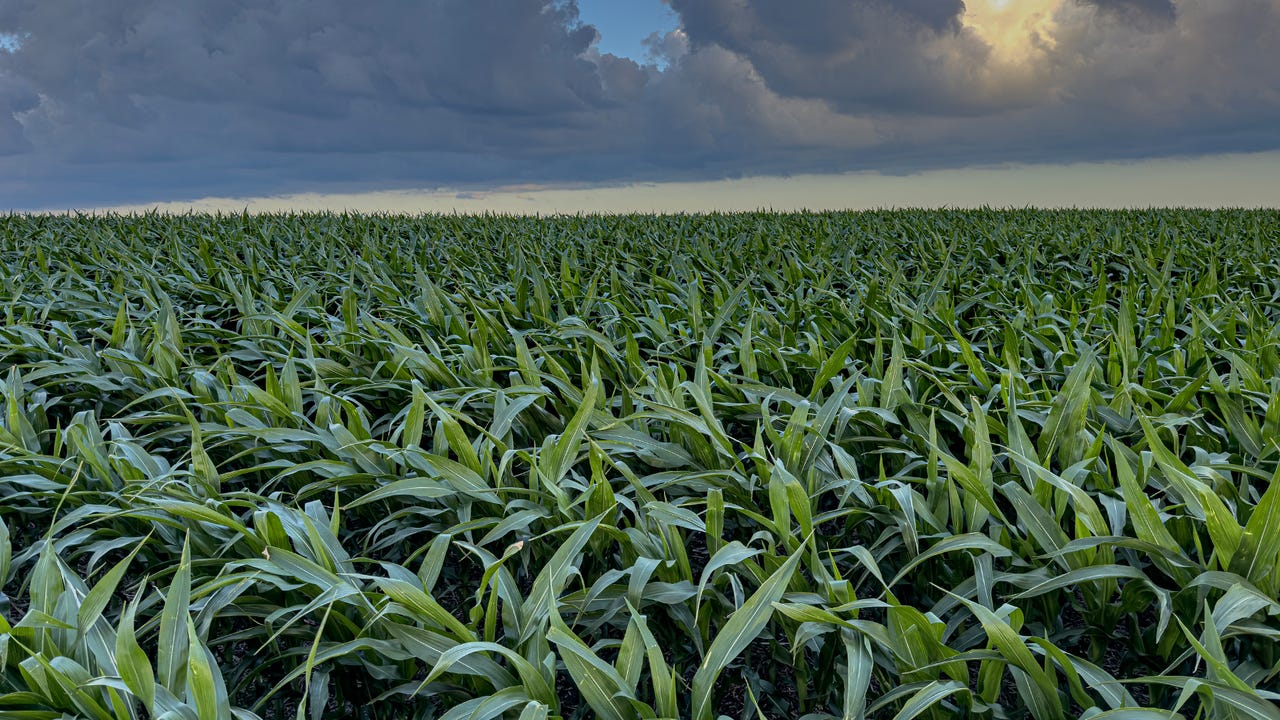Late in 2022, Mitchell Hora found an obscure spark that could ignite new revenues for farmers tucked inside the massive Inflation Reduction Act of 2022.
“It was a light-bulb moment for me,” says Hora, a Washington, Iowa, farmer and founder and CEO of the software company Continuum Ag. While perusing the IRA, he found Section 45Z, which grants federal tax credits to biofuel manufacturers who make low-carbon fuels.
The tax credit’s worth is based on a carbon intensification (CI) score that tracks the biofuel supply chain’s carbon footprint. This includes greenhouse gas emissions such as carbon dioxide, nitrous oxide and methane that can fuel climate change.
The fewer emissions used to produce a gallon of biofuel, such as ethanol or biodiesel, the more tax credits — and money — biofuel companies glean. Farmers play a part in reducing these emissions since the answer is literally under their feet. Soil health practices they implement — such as cover crops, reduced tillage and efficient fertilizer use — also can reduce or sequester greenhouse gas emissions.
Currently, nothing in Section 45Z states that biofuel producers must share the money from tax credits with anyone. Still, Hora thinks they will share it with farmers, grain merchandisers, third-party verifiers and others. He estimates tax credits potentially could be worth more than $100 per acre in sharable value.
“[Section 45 Z] could be absolutely game-changing for my family's farm and other family farms across the country,” he says. “I think it’s going to have a ripple effect that changes global agriculture.”
How so?
Voluntary programs that pay farmers to adopt practices to sequester or reduce greenhouse gases gained momentum in the late 2010s. One type — offset programs — pays farmers for soil health strategies to offset greenhouse gases emitted by companies making their products.
It’s not that simple, though. Some offset programs contain additionality clauses, which nix payment for prior practices farmers use to slash greenhouse gas emissions.
“If a producer switched from conventional tillage to no-till 20 years ago and picked up cover crops a decade ago, they're actually precluded from participating in a lot of these carbon markets,” says Sean McMahon, U.S. sustainability manager for FarmersEdge, a Canadian firm that provides agribusinesses and crop insurers technology services.
Others contain permanence clauses thatpay farmers for greenhouse gas-reducing practices for a certain duration. A farmer who converted to greenhouse gas-sequestering no-till would void a contract if they switched to tillage, according to a University of Wisconsin Extension analysis.
“Some of these programs in a voluntary carbon [offset] market have a lot of red tape and hurdles,” Hora says.
That’s not so with potential Section 45Z payments. Unlike current carbon programs, there’s no contract to sign, nor are farmers who have installed prior greenhouse gas-sapping practices excluded.
Instead, potential payments are tied to the carbon footprint of each bushel a farmer grows, Hora says. The lower a farmer’s CI score, the higher the payments.
This appeals to Josh Nelson, who farms near Belmond, Iowa.
“This is an opportunity to pay farmers for practices they have been doing for a while,” he says. “Under [Section] 45Z, you could potentially get a payment for soil health practices that improve your CI score.”
All this ties into hungry global demand for low-carbon fuels, says Monte Shaw, Iowa Renewable Fuels Association executive director.
“Almost every major market that we see requires low-carbon ethanol,” he says. “The aviation industry wants it. Marine vessel fleets want it. The railroad industry wants locomotives that can generate electricity from low-carbon ethanol instead of diesel fuel.”
Biofuel win
Section 45Z was a winner in the One Big Beautiful Bill Act that President Donald Trump signed on July 4. Provisions include:
- an extension of biofuel tax credits through 2029 (Initially, they were set to expire in 2027.)
- a mandate that tax credits apply only to North American feedstocks such as corn and soybeans (It excludes foreign feedstocks, such as those used to make Chinese cooking oil.)
- tax credit transferability (This allows biofuel producers to sell credits they can't directly use.)

ADDITIONAL REVENUE: Although corn prices are depressed due to a monster crop on the way, carbon intensification scoring under Section 45Z may unlock new revenue opportunities for farmers.
Congress also eliminated a part of the full life-cycle analysis within Section 45Z called indirect land use change (ILUC). This modeling method calculates how potential changes in economic demand for a crop affects global land use, says Karen Boyd, World Energy director of product sustainability. She says it’s important to remember that ILUC is just an economic model based on possible changes in future demand and cannot be directly measured or affected by an individual.
“If you grow soybeans, [45Z-induced production] may create additional demand for soybean oil due to it being utilized to produce fuel,” Boyd says.
ILUC modeling shows how this potential fuel use may impact land use for other soybean uses. It may mean land demand to grow soybeans for food and other purposes could come from areas such as a Brazilian rain forest converted into new farmland, she says.
CI scoring specifics
CI scoring works on a sliding scale for fuel, grain and oilseeds. Average CI scores include:
- gasoline: 100
- ethanol: 55
- corn: 29.1
Biofuels companies could earn a 2-cent-per-CI-point reduction per gallon under the Section 45Z tax credit, Shaw says.
Nixing the ILUC alone will reduce the CI score for a typical Midwestern ethanol plant from 55 to 45, Shaw says. If combined with a 10-cent-per-gallon tax credit, an ethanol plant that annually produces 100 million gallons of ethanol could glean $10 million. Plants could use this money to pay farmers and others, upgrade capacity or make plant improvements.
“With these changes, I think the vast majority of ethanol plants are going to be able to qualify for the tax credits,” Shaw says.
Meanwhile, corn producers can lower their 29.1 CI score through various greenhouse gas-slashing practices. Nelson has lowered his CI score for corn to 5 by:
- planting cover crops on a share of his acres
- strip-tilling and no-tilling corn
- implementing a three-crop rotation including corn, soybeans and small grains (oats/rye)
- reducing nitrogen application to approximately 0.6 pounds per bushel for corn
- applying hog manure as a nutrient source
- improving fertilizer management using soil tests such as one for pre-sidedressed soil nitrate
Unknowns
Still, many unknowns exist, as Section 45Z now goes to the Treasury Department’s Internal Revenue Service to write regulations. The Treasury Department may consult with USDA and the Department of Energy, which were previously involved with Section 45Z provisions. Since it’s a tax issue, however, the Treasury Department has final say.
“Without final Treasury regulations, it’s difficult to predict exactly how farmers will benefit,” Shaw says.
Shaw believes the Treasury Department will create a pathway for farmers to receive individualized CI scores for low-carbon practices. Questions remain about what practices will be included and what model will be used to track these.
“USDA [under the Biden administration] didn’t recognize manure, and that’s one of the biggest [low-carbon] practices you can do,” Shaw says.
Monetization by farmers also remains uncertain. Much depends on how the Treasury Department tracks CI credits, Shaw says. The current draft uses mass balance, which links bushels and low-carbon credits for delivery to a biofuel producer.
“We have said from the beginning that mass balance is a mistake,” Shaw says. “It lumps corn [and other crops] together. Unless you’re selling directly to the plant, it is very limiting.”
The book-and-claim tracking system, which separates bushels and low-carbon credit certification, is better, Shaw says. It would enable farmers to separately sell their environmental attributes from their own CI scores from their grain and oilseed bushels.

CARBON SEQUESTRATION: Deep-rich soils hold the answer for sequestering greenhouse gases.
“If I'm 400 miles away from the nearest ethanol plant but can raise low-carbon corn, I could sell that credit to the ethanol plant,” Shaw says. “Book-and-claim would give every farmer a chance to participate and enlarge the ability to produce low-carbon ethanol.”
Other concerns
Extending the 45Z tax credit from 2027 to 2029 also was a win, Shaw says. Still, it dashed hopes for a 2031 extension. “This credit [through 2029] is not long enough for a plant to finance, build and operationalize major projects,” Shaw says.
Unless the credit is extended past 2029, biofuel plant managers will closely scrutinize and may pass on major investments, he adds.
ILEC also hasn’t gone away completely, Boyd says.
“It’s still part of other CI calculations that fuel producers’ value, such as California's [low-carbon fuel standard] or [Carbon Offsetting and Reduction Scheme for International Aviation],” Boyd says. “Depending on the policy that is used to value the fuel, [ILUC] still is applicable.”
What to do
Hora hopes book-and-claim tracking will prevail. For now, though, he advises farmers, biofuel producers, grain merchandisers, elevators and other supply chain members to ready themselves for linked data and crop under mass balance tracking. This requires knowing the CI scores of the grain and verifying bushels at every point of aggregation.
“Every single step along the chain will undergo an audit,” Hora says.
If you want to know your CI score, Continuum Ag offers CI scoring. Iowa State University also offers a CI score calculator.
Knowing their CI score can help farmers decide which future low-carbon opportunities to pursue, says Eric Gibson, farm input and crop production sustainability analyst for Rabobank.
“You can only improve what you can measure,” he says.
Be careful. “Practices like cover crops are not inexpensive to implement,” says Tim Laatsch, North America director of agronomy for Koch Agronomic Services. “They carry some benefits, but they take time to materialize. They come with a learning curve, and some yield penalty if you aren't managing at a high level.”
Long term, however, Nelson sees the movement toward carbon intensification and low-carbon grains and oilseeds as a lasting trend. “You see Nestle, Unilever and European companies interested in paying farmers for their data to meet their [environmental, social and governance] goals,” he says. “Companies in Asia are also looking at their own ESG models. The idea of climate change or carbon removal is kind of off limits right now politically [in the U.S.], but I don't think it's going away globally.”